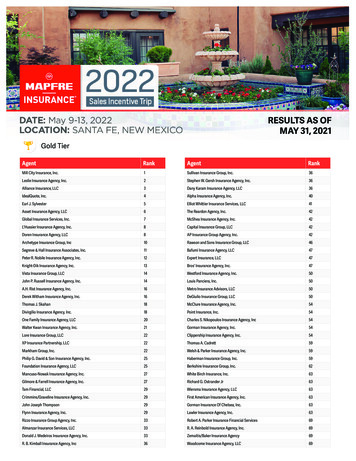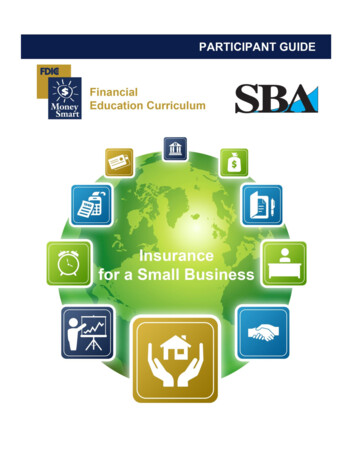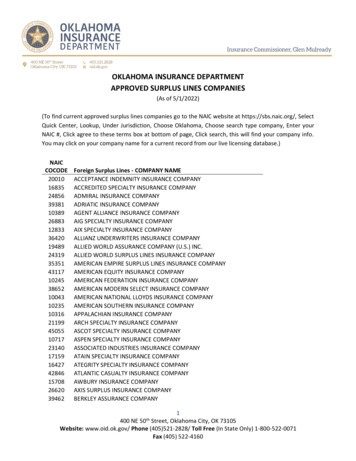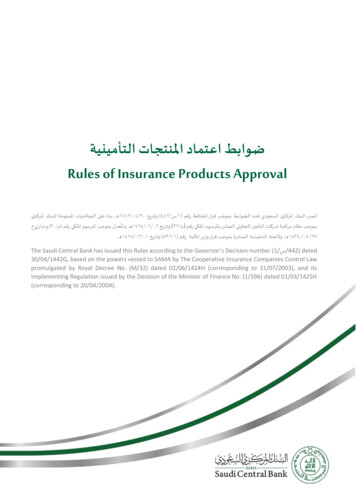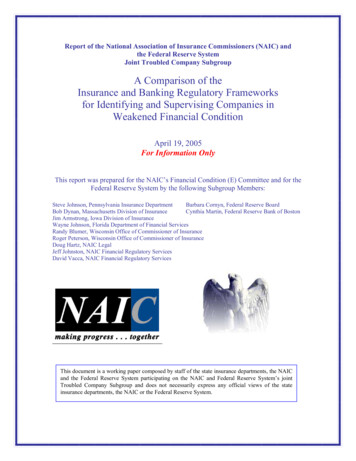
Transcription
Report of the National Association of Insurance Commissioners (NAIC) andthe Federal Reserve SystemJoint Troubled Company SubgroupA Comparison of theInsurance and Banking Regulatory Frameworksfor Identifying and Supervising Companies inWeakened Financial ConditionApril 19, 2005For Information OnlyThis report was prepared for the NAIC’s Financial Condition (E) Committee and for theFederal Reserve System by the following Subgroup Members:Steve Johnson, Pennsylvania Insurance DepartmentBarbara Cornyn, Federal Reserve BoardBob Dynan, Massachusetts Division of InsuranceCynthia Martin, Federal Reserve Bank of BostonJim Armstrong, Iowa Division of InsuranceWayne Johnson, Florida Department of Financial ServicesRandy Blumer, Wisconsin Office of Commissioner of InsuranceRoger Peterson, Wisconsin Office of Commissioner of InsuranceDoug Hartz, NAIC LegalJeff Johnston, NAIC Financial Regulatory ServicesDavid Vacca, NAIC Financial Regulatory ServicesThis document is a working paper composed by staff of the state insurance departments, the NAICand the Federal Reserve System participating on the NAIC and Federal Reserve System’s jointTroubled Company Subgroup and does not necessarily express any official views of the stateinsurance departments, the NAIC or the Federal Reserve System.
This page is intentionally left blank for printing purposes.
TABLE OF CONTENTSTopicPageIntroduction ------------------------------------------------ 1Background on the Gramm-Leach-Bliley Act (GLB Act) -------------------------------------------- 3Overview of Frameworks for Supervising Insurance and Banking Organizations----------------- 5Insurance -------------------------------------------- 5Banking --------------------------------------------- 8Tools for Identifying Financially Weakened ----10Insurance cial Reporting ---------------------10Solvency Screening and Financial Analysis Systems--------------------------------11State Insurance Department Financial Examination Process --------------------- 13Regulatory Capital Framework for Insurance Companies --------------------------14Databases and Information Systems -15Banking (State Member Banks and Bank Holding Companies) -----------------------------16Financial ------------------------------16Surveillance and Monitoring ----------16Bank Examinations and BHC Inspections latory Capital Frameworks ------18Databases and Information Systems -20Approaches for Supervising a Financially Weakened Company ------------------------------------21State Insurance Departments --------------------21Federal Reserve System -------------------------22Receivership and Liquidation --------------------------24State Insurance Supervisors ---------------------24Bank Supervisors -------------------------------- 25Conclusion Summary of State Regulation for Identifying and Supervising FinanciallyWeakened Insurers ------------------- Appendix ASummary of Framework for Identifying and Supervising Financially Weakened StateMember Banks and Bank Holding Companies ------------------------------------- Appendix B
INTRODUCTIONThe National Association of Insurance Commissioners (NAIC) and the Federal ReserveSystem (FRS) joint Troubled Company Subgroup (Subgroup) was formed in 2000.1 TheSubgroup’s objective was to compare insurance and banking regulatory frameworks foridentifying and supervising companies in weakened financial condition, and was one offour joint subgroups established by the NAIC and the FRS to address implementation ofthe Gramm-Leach-Bliley Act (GLB Act) enacted in November 1999.2 The GLB Actfacilitated the already growing integration of the insurance, banking and securities sectorsby permitting wider latitude for insurance companies, banks and securities firms tooperate within a single financial holding company (FHC), and mandated the coordinatedsupervision of entities within an FHC by the financial sector regulators. The joint effortsof the insurance and banking supervisors over the past several years have provided afoundation for effective communication and coordination between the state insurancedepartments and the FRS consistent with the GLB Act.Topics presented and discussed by Subgroup members and guest speakers included: 1)regulatory financial reporting frameworks; 2) off-site surveillance and monitoringincluding “early warning systems” for identifying supervised companies having weak ordeteriorating financial conditions; 3) on-site examinations; 4) corrective action plans; 5)enforcement powers; 6) risk-based capital (RBC) frameworks; 7) resolution processes forfailing and failed insurance companies and banks; and 8) the FRS’s role as umbrellasupervisor for FHCs. Separately, in connection with this initiative, staff of the FederalDeposit Insurance Corporation (FDIC) presented a summary of that agency’s resolutionprocedures to the NAIC task force members. In comparing the two frameworks of law,regulation, policy and procedures, the Subgroup members and other discussants stressedthat the specific supervisory approaches taken for any given financially weakenedinsurance or banking company are dependent upon the specific facts and circumstancesas well as upon the respective supervisory frameworks.The Subgroup found that the frameworks for identifying and supervising financiallyweakened companies used by state insurance regulators and the FRS have manysimilarities. For example, both the state insurance departments and the FRS:1The Subgroup’s initiative was conducted by staff from several state insurance departments, the NAIC, theBoard of Governors of the Federal Reserve System (Federal Reserve Board) and the Federal Reserve Bankof Boston under the auspices of the NAIC’s Financial Condition (E) Committee. The Subgroup, which wasoriginally established under the NAIC Coordinating with Federal Regulators Working Group now reportsup through the NAIC Financial Analysis Working Group (FAWG) of the NAIC Financial Condition (E)Committee.2Unless otherwise noted, the banking supervisory framework presented in this paper is the approach usedby the FRS as it pertains to state member banks and bank holding companies (BHCs). The FRS also hassupervisory responsibility for certain U.S. bank branches and certain other U.S. banking offices of foreignbanking organizations (FBOs); however, the scope of this summary does not include FBO supervision.Additionally, the scope of this summary was generally limited to financial soundness monitoring and thesupervision of financially weakened institutions. Comparisons of frameworks for identifying andcorrecting issues pertaining to compliance with consumer protection regulations were also beyond thescope of this summary.1
generally require supervised institutions to file detailed quarterly financialcondition and income reports, related supplementary information, andinformation identifying affiliated entities of an insurer or a bank;conduct routine off-site monitoring of supervised companies other than small,noncomplex BHCs, in part based upon information contained in regulatoryreports, and also using market information, to assist in early identification offinancially weakened companies and in allocating on-site examinationresources;have minimum capital standards, including an RBC framework that requiresregulatory intervention when capital of a supervised insurance company orinsured bank falls below a designated level;3impose limitations on and reporting requirements related to certaintransactions within holding company systems, including certain acquisitionsof or by a supervised entity;may require a financially weakened, supervised company to develop writtencorrective action plans and submit progress reports on compliance with plans;andmay take various other supervisory actions against a financially weakenedcompany, including imposing restrictions on activities.The Subgroup also identified three broad phases of supervisory activities as follows:1) conducting both off-site monitoring of financial condition using financialstatement and market information analysis, and on-site examinations;2) implementing corrective action plans for financially weakened companies; and3) undertaking insolvency proceedings (generally the responsibility of the FDICfor bank insolvencies).The attached Appendices A and B contain summary information regarding the insuranceand banking regulatory processes for identifying and supervising financially weakenedinsurance and banking organizations.3State insurance departments and certain bank regulators are responsible for handling insurance companyand bank insolvencies, respectively; insolvencies of insurance holding companies and BHCs are handledunder federal bankruptcy laws.2
BACKGROUND ON THE GLB ACTThe GLB Act amendments to the Bank Holding Company Act of 1956 (BHC Act)authorized a qualifying bank holding company (BHC) to operate as an FHC and toengage in a diversified range of financial activities, including insurance sales, insuranceunderwriting, securities underwriting and dealing, acting as a futures commissionmerchant, and engaging in merchant banking. To qualify as an FHC, each of the BHC'sdepository institution subsidiaries must be well capitalized and well managed and each ofthe BHC’s insured depository subsidiaries must have received at least a “Satisfactory”Community Reinvestment Act (CRA) rating in its most recent CRA examination.4Those insurance activities that are permitted to be conducted by an FHC include insuring,guaranteeing, or indemnifying against loss, harm, damage, illness, disability, or death;providing and issuing annuities; and acting as principal, agent, or broker for the foregoingactivities. Permissible activities also include those that the Federal Reserve Board andthe Secretary of Treasury jointly determine to be financial in nature or incidental tofinancial activities, or that the Federal Reserve Board determines are complementary to afinancial activity and do not pose a substantial risk to the safety and soundness ofdepository institutions or the financially system generally.Under the GLB Act, state regulation of insurance is preserved. A state law applicable toinsurance may be preempted, however, if it prevents or restricts a depository institutionor a depository institution affiliate from engaging in any activity authorized under theGLB Act. For instance, state laws relating to insurance sales, solicitation and crossmarketing activities may not prevent or significantly interfere with the ability of a bank orbank affiliate to engage in insurance sales activities.With limited exceptions that existed prior to the passage of the GLB Act, insuranceunderwriting activities of an FHC may only be conducted by the FHC parent company orby a nonbank subsidiary of the FHC. A bank and its subsidiaries are generally precludedfrom insurance underwriting, other than the underwriting of credit life and credit healthproducts. As set forth in the GLB Act, general insurance sales may be conducted by anFHC parent company or a nonbank subsidiary of the FHC, or by a financial subsidiary ofa bank. The GLB Act did not change the authority for national or state-chartered banksto sell or underwrite insurance directly. Federal banking laws, however, generallycontinue to limit insurance underwriting activities of banks to credit-related underwritingactivities. Most state banking laws now permit state-chartered banks to sell generalinsurance.The Federal Reserve Board is the umbrella supervisor of BHCs, including FHCs. Inaccordance with the GLB Act, the Federal Reserve Board is to rely to the fullest extentpossible on reports of examination made by the applicable functional securities and4A CRA rating is an indicator of how well the depository institution has met its legal requirement to serveits community, in accordance with applicable laws and regulations. CRA examinations are conducted by adepository institution’s primary federal banking regulator.3
insurance regulators, including for any licensed insurance company and any othersubsidiary that the Federal Reserve Board finds to be comprehensively supervised by afederal or state authority. If information that is needed to assess the risk of a functionallyregulated subsidiary of a banking organization is not available from the functionalregulator, the Federal Reserve Board may examine a functionally regulated subsidiary ofa BHC only if: the Federal Reserve Board has reasonable cause to believe that suchsubsidiary is engaged in activities that pose a material risk to an affiliated depositoryinstitution; the Federal Reserve Board reasonably determines, after reviewing relevantreports, that examination of the subsidiary is necessary to adequately inform the Board ofthe systems for monitoring and controlling operational risks that may pose a threat to thesafety and soundness of a depository institution subsidiary of the BHC; or, based onreports and other available information, the Federal Reserve Board has reasonable causeto believe that the subsidiary is not in compliance with the GLB Act or any other federallaw that the Federal Reserve Board has jurisdiction to enforce against such subsidiary,and the Federal Reserve Board cannot make such a determination through examination ofthe affiliated depository institution or the bank holding company.4
OVERVIEW OF FRAMEWORKS FOR SUPERVISING INSURANCE ANDBANKING ORGANIZATIONSInsuranceThe primary objective of insurance regulation is to correct market failures that wouldotherwise cause insurers to incur an excessive risk of insolvency or engage in marketabuses that hurt consumers. Significant state insurance department regulatory resourcesare employed to monitor market behaviors, compliance, and solvency.Each state, the District of Columbia, and the U.S. territories5 are responsible forregulating the insurance business within their own jurisdictions. Each state maintains itsown insurance department, which operates under the supervision of a commissioner,director, or superintendent who is either appointed or elected. Some states havecombined the regulation of insurance, banking, and securities, activities under onedepartment or office.The NAIC, formed in 1871, is a private, non-profit, voluntary association of the chiefinsurance regulatory officials of the 50 states, the District of Columbia, and the four U.Sterritories (American Samoa, Guam, Puerto Rico, and the Virgin Islands). The NAICprovides its members with a forum for discussing common interests and for workingcooperatively on regulatory matters that transcend the boundaries of their ownjurisdictions. The NAIC is not a regulatory body or a trade association, but is instead anorganization whose members consist solely of insurance regulators for the purpose offacilitating communication and interaction among insurance regulators to enhanceinsurance regulation and establish national standards, where appropriate.The objective of the NAIC is to serve the public interest by assisting state insurancesupervisory officials, individually and collectively, in achieving the followingfundamental insurance regulatory objectives: 1) protect the public interest, promotecompetitive markets and facilitate the fair and equitable treatment of insuranceconsumers; 2) promote the reliability, solvency and financial solidity of insuranceinstitutions; and 3) support and improve state regulation of insurance. The primarymeans for NAIC members to be actively involved in the association is through the NAICcommittee system. Each commissioner serves, or delegates to state insurance departmentstaff, the responsibility to serve on various NAIC committees, task forces and workinggroups. The NAIC is committed to conducting its business openly, subject to thediscretion of the chairpersons of committees, subcommittees, tasks forces, workinggroups and subgroups, who may determine those situations in which public discussionswould not be appropriate.The NAIC coordinates and assists state solvency efforts in a number of ways, including:1) maintaining extensive insurance databases and a computer network that are assessable5The fifty states, the District of Columbia, and the U.S. territories are collectively referred to as “states” inthis document.5
to all state insurance departments; 2) analyzing and informing regulators as to thefinancial condition of insurance companies; 3) coordinating examinations and regulatoryactions with respect to financially weakened companies; 4) establishing and certifyingstates’ compliance with minimum financial regulation standards through the NAIC’sFinancial Regulations Standards and Accreditation Program (Accreditation Program); 5)providing financial, reinsurance, actuarial, legal, computer and economic expertise tostate insurance departments; 6) valuing securities held by insurers; 7) analyzing andlisting nonadmitted alien insurers;6 8) developing uniform statutory financial statementsand accounting rules for insurers; 9) conducting education and training programs forinsurance department staff; 10) developing model laws and coordinating regulatorypolicy on significant insurance issues; and 11) conducting research and providinginformation on insurance and its regulation to regulators, state legislators, Congress, U.S.government agencies, insurance regulators in other countries, and the general public.In June 1989, the NAIC adopted the Financial Regulation Standards (the Standards), thatestablished baseline sound practices for an effective regulatory system in each insurancedepartment. The Standards are applied through a formal, voluntary certification programadministrated by the NAIC. The objective of the Accreditation Program is to provide aprocess whereby solvency regulation of multi-state insurance companies can be enhancedand adequately monitored by the states. The Standards are grouped into three areas: 1)laws and regulations; 2) regulatory practices and procedures; and 3) organizational andpersonnel practices. Under this Accreditation Program, an independent team ofexperienced consultants reviews each insurance department’s compliance with theStandards at least every five years. All states have enacted legislation designed toachieve compliance with the Standards, and as a result, insurance department budgets andstaffing have increased significantly. As of March 1, 2005, 49 states and the District ofColumbia were accredited under the Accreditation Program.Insurance companies are chartered by individual jurisdictions and receive a certificate ofauthority (that is, a license) to conduct business from each jurisdiction in which thecompany desires to underwrite insurance. This has been the case since 1792, whenchartered insurance companies were first required by the states to limit companyactivities and investments, and to file financial statements. The power of a state toregulate insurance was established in 1869 in Paul v. Virginia, where insurance was6A nonadmitted insurer is a company not licensed by a state to sell insurance policies within the state.Alien insurers are those formed according to the legal requirements of a foreign country. In order for analien insurer to conduct operations and sell its products in a particular state, the insurer must conform to thestate’s rules and regulations governing insurance companies. A nonadmitted alien insurer may be allowedto write on a surplus lines basis if it complies with the state’s eligibility requirements. To assist states intheir review of nonadmitted alien insurers, the NAIC produces a Quarterly Listing of Nonadmitted AlienInsurers (the Listing). If an insurer appears in the Listing, it has filed specified documents with the NAICInternational Insurers Department (IID) and, based upon these documents and other information, appears tofulfill the criteria for eligibility set forth by the NAIC. Several states utilize the Listing to some capacitywithin their respective state statutes or regulations in relation to their eligibility requirements.6
declared a local matter rather than commerce between the states. By 1870, many of thestates had appointed a state official to oversee insurance.In 1944, the U.S. Supreme Court in United States v. South-Eastern UnderwritersAssociation ruled that insurance was “commerce” and subject in its interstate activity toregulation by the Congress and the statutory restriction of the Sherman Act prohibitionagainst restraint of trade. In 1945, however, Congress enacted the McCarran-FergusonAct, which included a limited exception from certain antitrust laws for certain insurancerelated activities. The McCarran-Ferguson Act generally made insurance subject to statecontrol and withheld the application of federal statutes to the extent that state lawregulated such business, except in instances where the federal law specifically relates toinsurance.The states issue a number of different insurance company license types, including life andhealth, and property and casualty licenses. The states also issue insurance producerlicense types, including broker, independent agents, managing general agents, andgeneral agent licenses.7 Reinsurers may either be authorized or licensed to writereinsurance business depending on the states laws and regulations. Under state insurancelaw, provided the owner meets certain criteria through the regulatory approval process,there are very few outright restrictions on a licensed insurer’s ownership by, or affiliationwith, other financial or non-financial companies. An exception is the general prohibitionon foreign government ownership of an insurer.State insurance law does not provide for consolidated supervision of the insuranceholding company or the parent holding company. However, an insurance company issubject to state restrictions and disclosures regarding inter-affiliate relationships, andchange in ownership is subject to state insurance department approval. Under state law, alicensed insurance company is generally authorized to own subsidiaries that conductinsurance or insurance-related business activities, including real estate management andreal estate development. Investments in higher risk activities are limited by state statutesand indirectly through statutory RBC minimum standards.State insurance regulators have recognized a growing need to more fully coordinate theirregulatory efforts with other state insurance regulators, including efforts for sharingconfidential supervisory information.Historically, there has been significantcoordination with respect to supervising financially weakened companies; similar effortsare also underway to focus on holding company systems or insurance groups that arefinancially strong. In 2000, the NAIC formed the Insurance Holding Company (E)Working Group (IHCWG) in an effort to document a framework for information sharingand coordination of regulatory processes for analyzing insurance holding companies andtheir insurance subsidiaries. The NAIC Framework for Insurance Holding Company7An independent agent is a contractor who represents more than one insurance company when placing aclient’s business. A general agent is a person appointed by one insurer who is responsible for insuranceagency operations in a particular geographical area, including the sale of life and health insurance,recruiting and training agents, and providing administrative support.7
Regulation (Framework) is the result of the IHCWG’s work. The Framework providesguidance for state insurance regulators to understand the holding company structure ofinsurers operating in their state, as well as to coordinate their supervisory approaches forreviewing holding company transactions that may impact insurance subsidiariesdomiciled in multiple jurisdictions. Currently, this Framework is in the implementationstage.BankingThe FRS is the primary federal banking regulator for state member banks. It also hassupervisory authority for all U.S. bank holding companies. In the U.S., commercialbanks are either federally chartered by the Comptroller of the Currency (OCC) asnational banks, or are chartered by a state. National banks are supervised by the OCCand are members of the FRS. State-chartered banks that are members of the FRS arereferred to as state member banks, and are supervised by both the applicable statebanking department(s) and the FRS. A state bank that does not choose to become amember of the FRS is referred to as a state nonmember bank and is supervised by boththe applicable state banking department(s) and the FDIC. The OCC, FRS and FDIC arethe primary federal bank supervisors for national banks, state member banks and statenonmember banks, respectively. A “dual banking system” exists in the U.S. wherebystate-chartered banks have both a federal bank and a state bank regulator(s).8 Therefore,the FRS actively coordinates its supervision of state member banks with the applicablestate banking department(s).Prior Federal Reserve Board approval is required for a company to initially become aBHC or for an existing BHC to acquire control of, or more than five percent of a class ofvoting securities of, additional BHCs or banks. Relevant federal statutes state thatcontrol of a BHC or bank exists when a company has (i) ownership, control, or power tovote 25 percent or more of the outstanding shares of any class of voting securities of theBHC or bank, directly or indirectly or acting through one or more other persons; (ii)control in any manner over the election of a majority of the directors, trustees, or generalpartners (or individuals exercising similar functions) of the BHC or bank; or (iii) thepower to exercise, directly or indirectly, a controlling influence over the management orpolicies of the BHC or bank. A company includes corporations, partnerships,associations, certain trusts, and similar organizations. Also, non-financial firms generallyare prohibited from controlling banks and thus are prohibited from owning 25 percent ormore of the voting stock of a bank.The FRS has supervisory authority over BHCs, including those that are FHCs, andsupervises these entities on a consolidated basis. The FRS supervisory approach reflectsthe “source of strength” doctrine, which asserts that a BHC should serve as a source offinancial and managerial strength to its subsidiary banks, within certain constraints. Thisdoctrine was reconfirmed in the GLB Act, except that the Act indicates that the FRScannot require a BHC that is an insurance company, or an insurance company that is an8A state-chartered bank may be subject to supervision in all states in which it operates.8
affiliate of a depository institution, to provide funds or other assets to the affiliateddepository institution if the state insurance authority makes a determination, in writing,that such action would have a material adverse effect on the financial condition of theinsurance company.The FRS is comprised of 12 regional Federal Reserve Banks under the general oversightof the Federal Reserve Board, which is located in Washington, D.C. The Federal ReserveBoard and its staff develop FRS regulations and policies. The Federal Reserve Board isan independent government agency overseen by 7 board members, including the FederalReserve Board Chairman and Vice Chairman, all of whom are appointed by the presidentand confirmed by the Senate. Each Federal Reserve Board member is appointed to servea 14-year term, or if replacing a board member whose term has not yet expired, to servethe remainder of the previous board member’s 14-year term. The Federal Reserve BoardChairman has a 4-year term, and may be reappointed.In carrying out responsibilities for the comprehensive supervision of BHCs, includingFHCs, the FRS coordinates and cooperates, as appropriate, with the other bank and thriftregulators, including the OCC, the FDIC, the Office of Thrift Supervision (OTS), andstate banking departments. The Federal Financial Institutions Examination Council(FFIEC), whose members consist of the FRS, OCC, OTS, FDIC and National CreditUnion Administration (NCUA), is an organization that fosters uniform depositoryinstitution regulatory reporting and consistent supervisory policy among those federalagencies. Moreover, federal and state bank and thrift supervisors share certain databasesand other supervision tools and resources in order to develop coordinated and consistentregulation of supervised entities.Additionally, in carrying out its role as the consolidated supervisor for BHCs, includingFHCs, the FRS also relies on and coordinates its supervisory activities with, asappropriate, the Securities and Exchange Commission (SEC) and the Commodity FuturesTrading Commission, and state insurance and securities regulators.9
TOOLS FOR IDENTIFYING FINANCIALLY WEAKENED INSTITUTIONSInsuranceFinancial ReportingThe NAIC reporting requirements have evolved considerably since its annual statementintroduction in 1879. All states require an insurer
The National Association of Insurance Commissioners (NAIC) and the Federal Reserve System (FRS) joint Troubled Company Subgroup (Subgroup) was formed in 2000.1 The Subgroup's objective was to compare insurance and banking regulatory frameworks for identifying and supervising companies in weakened financial condition, and was one of







